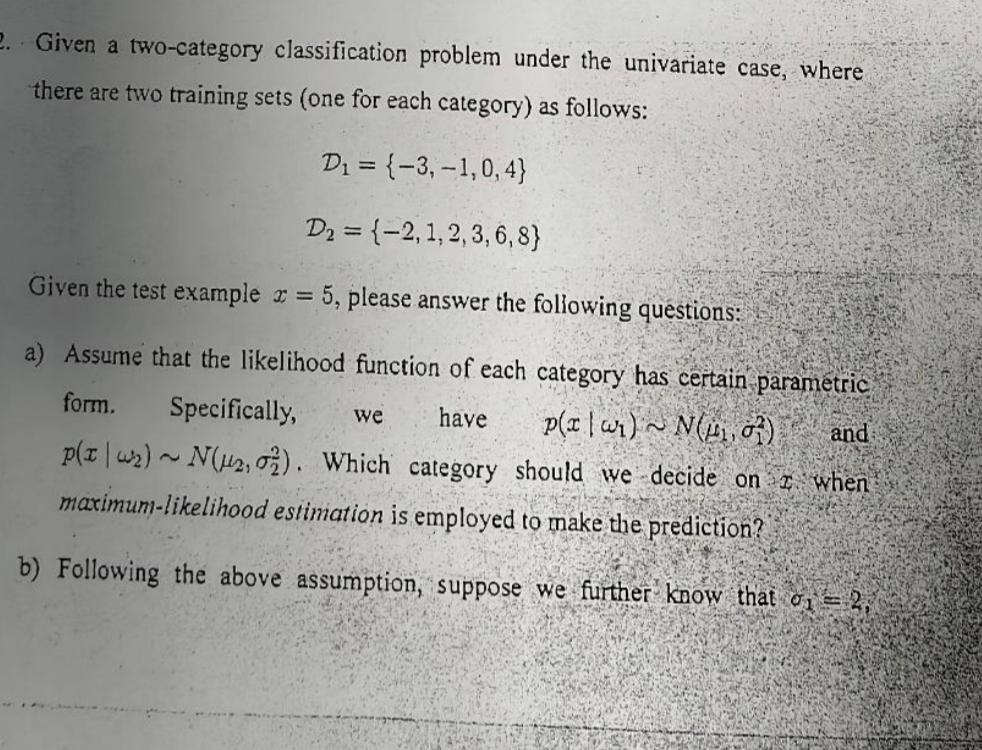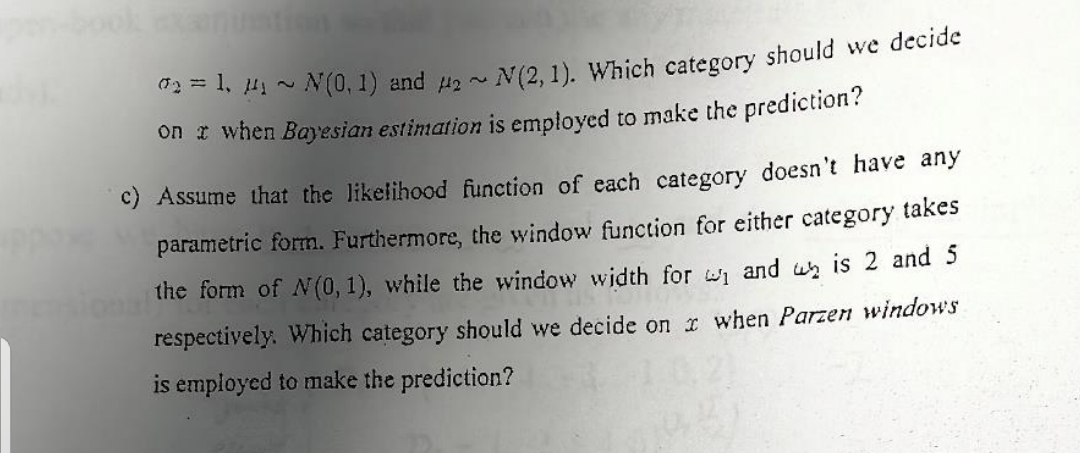Given a two-category classification problem under the univariate case, where there are two training sets (one for each category) as follows: D₁ = {-3,-1,0,4} D₂ = {2,1,2,3,6,8} Given the test example x = 5, please answer the following questions: =) Assume that the likelihood function of each category has certain parametric form. Specifically, we and p(x|w₂) have p(x|w₁) N(₁7) N(2, 2). Which category should we decide on when maximum-likelihood estimation is employed to make the prediction? ) Following the abou
Given a two-category classification problem under the univariate case, where there are two training sets (one for each category) as follows: D₁ = {-3,-1,0,4} D₂ = {2,1,2,3,6,8} Given the test example x = 5, please answer the following questions: =) Assume that the likelihood function of each category has certain parametric form. Specifically, we and p(x|w₂) have p(x|w₁) N(₁7) N(2, 2). Which category should we decide on when maximum-likelihood estimation is employed to make the prediction? ) Following the abou
Operations Research : Applications and Algorithms
4th Edition
ISBN:9780534380588
Author:Wayne L. Winston
Publisher:Wayne L. Winston
Chapter13: Decision Making Under Uncertainty
Section: Chapter Questions
Problem 8RP
Related questions
Question
give the steps by steps answer

Transcribed Image Text:2. Given a two-category classification problem under the univariate case, where
there are two training sets (one for each category) as follows:
D₁ = (-3,-1,0,4}
D₂ = {-2,1,2,3,6,8}
Given the test example x = 5, please answer the following questions:
have
and
a) Assume that the likelihood function of each category has certain paramétric
form. Specifically, we
p(x | w₁) N, 07)
p(x₂)~ N(μ₂, 02). Which category should we decide on when
maximum-likelihood estimation is employed to make the prediction?
b) Following the above assumption, suppose we further know that o = 2,

Transcribed Image Text:02= 1, ₁ ~ N(0, 1) and 2~ N(2, 1). Which category should we decide
on t when Bayesian estimation is employed to make the prediction?
c) Assume that the likelihood function of each category doesn't have any
parametric form. Furthermore, the window function for either category takes
the form of N(0, 1), while the window width for ₁ and is 2 and 5
respectively. Which category should we decide on x when Parzen windows
is employed to make the prediction?
Expert Solution
This question has been solved!
Explore an expertly crafted, step-by-step solution for a thorough understanding of key concepts.
This is a popular solution!
Trending now
This is a popular solution!
Step by step
Solved in 5 steps with 17 images

Follow-up Questions
Read through expert solutions to related follow-up questions below.
Follow-up Question
Given a two-category classification problem under the univariate case, where there are two training sets (one for each category) as follows: D₁ = (-3,-1,0,4} D₂ = {-2,1,2,3,6,8} Given the test example x = 5, please answer the following questions: have and a) Assume that the likelihood function of each category has certain paramétric form. Specifically, we p(x | w₁) N, 07) p(x₂)~ N(μ₂, 02). Which category should we decide on when maximum-likelihood estimation is employed to make the prediction?
Solution
Knowledge Booster
Learn more about
Need a deep-dive on the concept behind this application? Look no further. Learn more about this topic, computer-science and related others by exploring similar questions and additional content below.Recommended textbooks for you

Operations Research : Applications and Algorithms
Computer Science
ISBN:
9780534380588
Author:
Wayne L. Winston
Publisher:
Brooks Cole

Operations Research : Applications and Algorithms
Computer Science
ISBN:
9780534380588
Author:
Wayne L. Winston
Publisher:
Brooks Cole